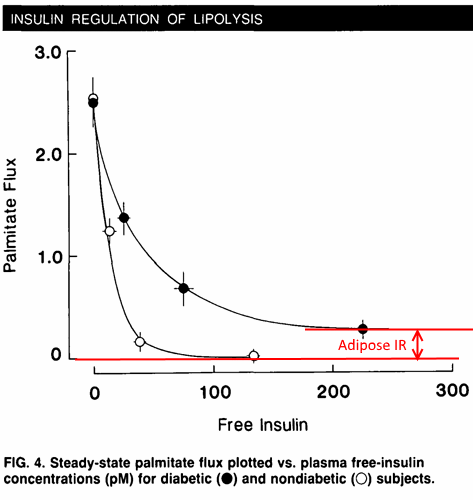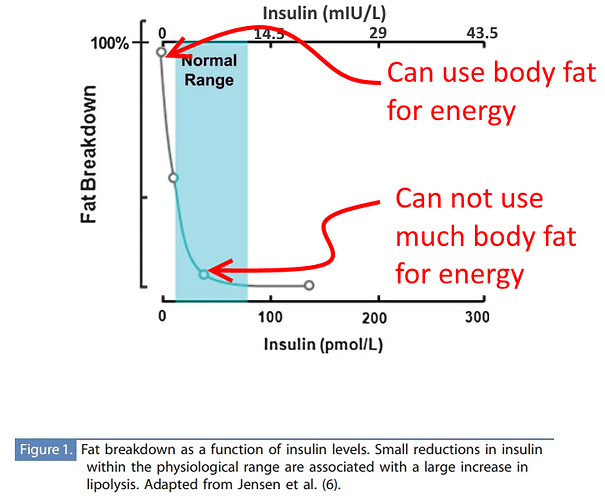Dr Jason Fung explained the difference between fasting and caloric restriction during one of the obesity code podcasts using a thought experiment (reductio ad absudum). I thought it was worth preserving it here.
Thought Experiment
Imagine 2 identical twins, let’s call them Adam and Barry both with 40 lbs of body fat. Each is measured and found to burn 2400 kCal/day. Each eats ONLY 1200 kCal, both appear to be at a 1200 kCal deficit – let’s assume the eat the same macro nutrient ratio 10 fat:25 protein: 65 carbs - that’s pretty much the diet that dietitians tell us to eat but I chose that so most of it’s energy is coming from insulinogenic sources.
Adam is going to eat one meal a day and fast the rest. Barry is going to eat 24 meals a day (this is the “ad absurdum” bit)
Fasting
Adam eats all 1200 kCal of his daily meal at midnight. His body responds by switching him to a fed state, his insulin goes up, as it does his fat cells switch from releasing energy to storing energy, his energy consuming cells switch from transporting fat into his mitochondria to be burned via beta oxidation, to oxidizing glucose through aerobic glycolysis. Eventually after 2 hours his insulin has returned to it’s nadir, and his fat cells now release free fatty acids into circulation, and his energic consumers switch back to shuttling fatty acids
into the mitochondria to be burned.
Caloric restriction
Barry eats his allotted meal over the entire day, so every hour on the hour he eats 50 kCal. His body responds by switching him to a fed state, his insulin goes up switching him from fasted to fed state with the same result as Adams … but the difference here is that before Barry’s insulin has had a chance to return to it’s fasted state … his next meal is already on him and he is back to a fed state again … and he stays there all day.
Same calories In: Different calorie calculus
The difference between the two is that in the 22 hours AFTER his one meal, Adam has access to as much energy as his adipose tissue can release in that time (31.5 kCal/lb/day * 40lbs = 1260 kCal). So over the 24 hours Adam has been able to budget for 1200+1260=2460 kCal of energic consumption – That’s a normal day for Adam and he’s just lost roughly 1/3 lb of body fat.
Over the same period Barry has had 1200 kCal from food to spend on his budgeted activities, and zero contribution from body fat – because his insulin was kept aloft like a beach ball at the cricket. So Barry has to make up a shortfall of 1200 kCal from budgetary cuts (reduction in MBR) and from alternate sources of energy (glucogenic Amino acids). So Barry has not only not lost any body fat, he may have lost lean tissue sacrificed to supply the short fall AND his metabolic rate has been kneecapped.
Adam fasted. Barry caloricly restricted.
What if they only ate protein
If Adam’s meal was just protein; let’s say 300g = 1200 kCal. Adam’s insulin response would have been less (than his meal with 65% carbs) but the remaining 22 hours would be identical. Barry’s would have still been a disaster, he would have still lost lean mass, and had his metabolic rate kneecapped.
What if they only ate fat
If the meals had just been fat for energy then both of them would have comfortably fasted (assuming minimal insulin response to 5.5 g=50 kCal of fat).
Why is this absurd example relevant?
People who have a high enough fasted insulin are like Barry 24/7.
Many people who are profoundly insulin resistant (type 2 diabetics) who switch to a ketogenic diet and lose 50-100-more lbs of body fat and then hit their plateau are in this category. This is why they can’t simply calorically restrict to get off their plateau until they can get their fasted insulin below the threshold of lipolysis.
Here is a chart from Jensen et al (which the chart above came from) that shows a diabetic with insulin resistance and a person who has healthy adipose that is responding to insulin

When a Diabetic starts keto they are a black dot and no amount of insulin will make the release of energy from body fat (palmitate flux) zero. That is insulin resistance in your fat cells - that difference between zero and 0.3. As soon as you lose enough body fat it starts hearing the signal of insulin and you go from being a black dot to a white dot and now you are on a plateau and tissue OTHER than body fat is keeping your insulin high.
This is why we suggest Keep calm and Keto On - because the longer you spend at a lower exposure of insulin the more insulin sensitive that tissue keeping insulin elevated can become.

